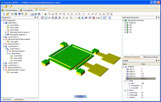Apr 2 2010
Coventor, Inc., the leading supplier of software solutions for developing micro-electromechanical systems (MEMS), today announced the release of the newest version of its CoventorWare MEMS design automation platform.
 CoventorWare MEMS Design Automation Software
CoventorWare MEMS Design Automation Software
The multi-faceted CAD, modeling and simulation suite offers new capabilities that will further accelerate the development and reduce the design cost of traditional MEMS devices, as well as address the evolving needs of emerging MEMS applications such as energy harvesting, resonators for timing devices and RF filters, and innovative motion sensing devices.
MEMS market research firm Yole Development had identified a number of new applications it calls Emerging MEMS devices that will drive growth in the $7 billion MEMS market over the next five years. These applications, many of which will be designed into high volume consumer products, are just reaching the commercialization phase and require new modeling and simulation capabilities in order for their developers to compete in fact-paced markets. The Yole report identifies at least 30 new start-ups working on Emerging MEMS applications
"MEMS devices are increasing in complexity, as well as in the functionality they can deliver. Our CoventorWare platform has established itself as the leading design and simulation suite for all phases of MEMS design -- from system level modeling, to detailed 3D simulation, to optimization for manufacturing yield improvements," said Mike Jamiolkowski, President and CEO at Coventor. "With our 2010 release we have not only improved performance, but have added important capabilities that address a rapidly emerging set of design requirements for exciting new MEMS-enabled applications."
Many emerging MEMS applications require high-frequency resonators based on piezo-electric or electro-mechanical effects. For high-frequency piezo-electric resonators, CoventorWare 2010 includes a new, unique mode-based approach to harmonic analysis that improves speed and ease of use. For electro-mechanical resonators of all types, a new solver called HarmonicEM extends CoventorWare's production-proven hybrid finite-element/boundary-element approach to the frequency domain, and includes non-linear spring-softening effects.
CoventorWare 2010 also supports the emerging application of MEMS-based energy harvesting or energy scavenging by allowing inclusion of an electrical load, in the form of circuit elements such as resistors, capacitors and inductors, in an analysis of a MEMS device. Accounting for the electrical load is crucial for optimizing the device design. The ability to simulate other energy loss mechanisms is also crucial to energy harvester and resonator design. In addition to its unique comprehensive capabilities for simulating gas damping, CoventorWare 2010 adds capabilities for analyzing energy loss via thermo-elastic damping and anchors.
All CoventorWare 2010 users, both for traditional and emerging MEMS applications, will benefit from enhanced performance and extended platform support. Performance has been enhanced through more efficient memory usage, more exploitation of multi-core CPUs, and simulating in 64-bit mode on Linux as well as Windows platforms. Platform support has been extended to include the 32- and 64-bit versions of Windows 7.
CoventorWare is comprised of three major modules that can be used individually to complement an existing design flow, or jointly to provide a complete MEMS design flow. These include Architect3D, Designer, and Analyzer. The completeness of the tool suite and the high-level of integration among the modules improves overall efficiency and ease of use, freeing users from the burden of manually transferring design data among multiple, stand-alone tools.
CoventorWare 2010 is available now.
Source: http://www.coventor.com